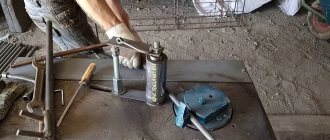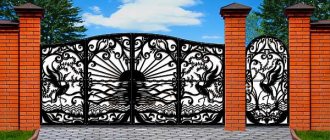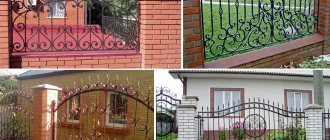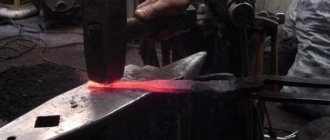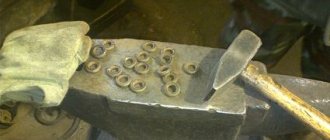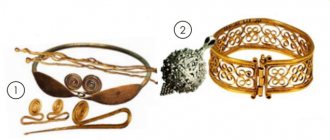According to technical terminology, artistic forging is a method of metal processing in which the required shapes and sizes are achieved through deformation. This definition hides one of the most ancient technologies, which allowed man to take a huge step in history and has not lost its significance today. Forging is actively used in metallurgy and mechanical engineering.
Handmade rose
History of appearance
The history of practical application and processing of metal goes back several thousand years. The history of the manufacture of artistic elements dates back just as many millennia, as evidenced by ancient archaeological finds. Primitive tips for spears and hoes show signs of creative processing. Previously, forging had a mainly practical orientation, but among the blacksmiths there were always craftsmen who knew how to combine practicality with artistry. Examples include samples of weapons and armor, horse harness, and household utensils.
The beginning of the formation of this art as an independent craft can be considered the Renaissance and the associated flowering of arts and science. Medieval palaces and temples in the Renaissance or Baroque style contain forged elements in their decoration, reflecting the spiritual, heraldic or simply aesthetic needs of the owners.
Notes
- ↑ 1 2 3 4 5 6 G. Semerak, K. Bogman
: Artistic forging and metalworking art, M: Mechanical Engineering, 1982, 232 p. - [dic.academic.ru/dic.nsf/bse/91374/Art Art and art industry - slovari.yandex.ru]
- [slovari.yandex.ru/art%20forging/Dictionary%20on social%20sciences/Art%20forging./Art Encyclopedia - slovari.yandex.ru](inaccessible link since 06/14/2016 (2090 days))
- Hephaestus // Real Dictionary of Classical Antiquities = Reallexikon des klassischen Altertums: Leipzig: BG Teubner Verlag, 1855: [trans. with German] / auto-comp. F. Lubker.
Tools
For many centuries, the standard set of blacksmith equipment and tools has not changed. A forge with coals, bellows for fanning them, a hammer and anvil, tongs and a barrel of water were the main tools of the blacksmith. The development of medieval production introduced elements of mechanization into this set, and the industrial revolution turned blacksmithing into an industry aimed at mass production of products.
Hammer and anvil
This direction received at its disposal a whole range of special equipment for artistic forging - machines and devices that made the blacksmith’s work easier and made it possible to produce complex products.
The classic coal forge still remains in the blacksmith's arsenal, but muffle furnaces and induction heaters have also come to its aid. Many forging machines retained their historical names, corresponding to their purpose - benders, snails, waves, twisters and torsion bars - but received a powerful electric drive or turned into universal multifunctional machines.
Advantages of Forging Processing
Kovkaprom produces and sells artistic elements in many cities of Russia. Their forged elements have very different directions. All these products have several positive qualities:
- Each piece is considered a unique and inimitable creation. Each element has its own individuality.
- Beautiful appearance.
- Forged parts are coated with a special anti-corrosion compound, so these elements can be used for decades.
- Due to the hardness of the metal, such products are always highly durable.
- The details are perfectly combined with various finishing and building materials. This allows us to implement the most original design solutions.
Types of blacksmithing
Forging technology includes several types of operations that differ in the tool used, execution modes and purpose. These operations are fully used in the technique of artistic forging, and the manufacture of any product can include any set and sequence of them. The main feature for classification is the processing temperature - hot and cold forging. Other criteria can also classify the operation into different types and subtypes.
Hot forging
During hot forging, the product is subjected to preliminary and, if necessary, accompanying heating to increase softness and ductility. There are two types of hot forging of metal:
- Free or hand forging, in which the workpiece is freely placed on an anvil, and the required shape and size are achieved by blows of a hand or mechanical hammer. This type also includes forge welding - the connection of parts heated to the melting temperature using a forging tool.
- Stamping, in which the workpiece is placed in a die with an internal cavity, the shape and size corresponding to the finished product. During the forging process, the workpiece is deformed and fills the empty die area.
Hot forging (Photo: pixabay.com)
Cold forging
In cold forging, the product is processed without preheating. It takes a lot of force to deform cold metal, so this method is used for processing small-section workpieces. Cold forging uses a variety of machines, including cold stamping.
Literature
- Art industry // Encyclopedic Dictionary of Brockhaus and Efron: in 86 volumes (82 volumes and 4 additional). - St. Petersburg, 1890-1907.
- A. Flerov, M. Demina, A. Elizarov, Y. Shemanov.
Techniques of artistic enamel, embossing and forging. - M.: Higher School, 1986. - 88 p. — ISBN 0486412237. - V. S. Ledzinsky, A. A. Telichko, A. V. Zverev.
Artistic forging and casting in Moscow. - M.: Mechanical Engineering, 1989. - 304 p. — ISBN 5-217-00245-X. - Denonvilliers Co.
1100 Decorative French Ironwork Designs. - Dover Publications, 2001. - 86 p. — ISBN 0486412237. - Akunin P.I.
Forging, embossing, inlay, enamel. - M.: Baro-Press, 2002. - 128 p. — ISBN 5-94004-148-5. - Ukhin S.V.
Artistic metal processing. - AST, Stalker, 2003. - 128 p. — ISBN 966-696-153-9. - Stuart Diana.
Decorative Architectural Ironwork. Featuring Wrought & Cast Designs. - Schiffer Books, 2004. - 224 p. — ISBN 9780764321924. - Borisova L.F.
Forging, embossing, inlay, enamel. - M.: Adelant, 2005. - 224 p. — ISBN 5-93642-006-X.
Basic Techniques
Each type of forging of metals and alloys has its own technologies and processing methods. Forging decorative elements uses in its arsenal almost all the basic techniques of blacksmithing, with the help of which any creative idea can be expressed in metal.
Disembarkation
The purpose of the operation is to reduce the length of the workpiece while simultaneously increasing the cross-section. In hot hand forging, the heated part is placed vertically on an anvil and hammered at the upper end. By heating individual places and holding the part with tongs, thickened nodes, bends, volumetric or flat elements of the intended decoration can be made on it.
Broach
Broaching is the opposite operation to upsetting and is used to lengthen the workpiece. The direction of impact when broaching is across the axis of the part with its rotation or advancement along its length.
Depending on the shape of the workpiece (flat, round, hollow, ring) and the equipment used, the broaching technique includes many techniques. Individual broaching techniques can be called by their own terms - spreading, flattening or rolling.
Blacksmith working
Rounding
The operation is used in hot forging methods and consists of rounding the edges of profile blanks. Initially, the corners of the workpiece are forged, bringing it to an octagonal cross-section. The final rounding is performed using special crimps or cutout hammers.
Threading
Threading is carried out in two ways - by assembling according to the principle of chain links or by flashing a hole in one of the elements. In this case, chisels of the required shape and size are used for the operation.
Decoration of ledges
Ledges of various shapes are made for both decorative and technological purposes in order to secure parts together. The ledges are made using sharp anvil ribs or special backing equipment.
Bending
Bending is a common technology actively used in artistic forging. Special machines and devices have been developed for bending, allowing craftsmen to work according to their own templates.
What is artistic forging
The first finds that can be attributed to artistic forging products date back to the 2-3 millennium BC, that is, the technology for making decorative elements by blacksmiths was used long before the advent of steel and iron. Over the centuries, the art has only improved, new materials and tools have appeared, right up to our time with industrial equipment and precision instruments.
An example of artistic forging: a helmet, late 12th-early 13th centuries.
This is a technology that is used to produce elegant products for both household use and decoration.
Products can be different; elements of artistic forging decorate entrance doors, gates or gates, furniture parts or lamps and many other things.
The main feature that such metal forging has is the presence of certain images and ornaments: branches of trees and flowers, animals and birds and other patterns, simple and complex.
Such products have always been valued; forged elegant things were a sign of wealth and a certain status. And even today, in our age of modern machine technology, nothing has changed, since fine manual work is very expensive and is accessible to a certain class of people.
It emphasizes the individuality and taste of the owner, and can also stylize the home for a certain time period.
DIY forged elements and parts
Today there are shops or workshops offering art products of their own production. The demand for these products is stable, despite the inflated cost of forged products.
If you wish and have some experience working with metal, you can do much of what professionals can do with your own hands. It is not at all necessary to arm yourself with a forge and a sledgehammer or purchase a special machine. Even for the manufacture of complex elements or products, a workbench, a vice, a welding machine and a hammer are sufficient. The material for amateur creativity will be a round rod, a profile pipe with a small cross-section, a narrow strip of steel or sheet metal.
Metal bending (Photo: pixabay.com)
Furniture
As furniture for self-production, you can consider garden or country tables and chairs, decorative shelves for walls. Forged elements can decorate the interior of a kitchen, bedroom, hallway or garden gazebo, and an old stool or floor lamp intended for scrapping can be reinforced with forged strips and presented as an antique.
Alcove
A gazebo is the cherished dream of summer residents and owners of their own plots; it does not have to be made of wood or brick. You can also make a metal structure from a profile. It is easy to turn it into a light and elegant composition with the help of hand-made forged parts - an openwork arch twisted from a steel circle at the entrance, curlicues around the perimeter of the gazebo or an intricate pendant for a lamp.
Gates
Forged gates and entrance gates are perhaps the most popular products from the range of artistic forging today, in which practicality is combined with artistic taste. Meanwhile, many owners of private houses, for economic reasons, make do with an entrance unit purchased or independently made from standard rolled metal and metal profiles.
Any metal structure can be classified as non-standard or made initially using the simplest self-made forged elements. The already mentioned steel rods, profiles or strips are used as a workpiece. From them you can make various twisted patterns and monograms, leaves and buds, strict or arbitrary geometric shapes.
Assortment of forged products
Forged gates
Forged gates are in great demand. They can be built into a wall or gate or located separately. The choice of a forged gate is very important, since the gate is the first thing people see when approaching the house. Fully forged fences are very common in European gardens; in our country, a combination of materials is more often used. Forging looks very beautiful with stone. The combination of forging and wood creates the feeling of a real medieval gate. Forged products are coated with paint of different colors, their height can also be different - from 1.5 to 3 or even 5 m.
Wrought iron furniture
Forged tables can be chosen in different designs, they come in different colors and sizes, and can combine different materials (combination with wood is a classic option, forged tables using glass are distinguished by the Art Nouveau style). Forged benches, as a rule, also represent a combination with wood, although there are also completely forged benches. A wrought-iron bed is what will be the highlight of your bedroom interior. Forged furniture is an excellent choice, because it is durable, stable, and very beautiful.
Forged arches and pergolas
Forged arches and forged pergolas are used to create corridors in a summer cottage; they are used for zoning a garden; they often serve as a support for climbing plants on the site. Forged arches and pergolas will highlight the beauty of flower beds and ponds.
Forged lanterns, lamps
The advantage of forged lanterns and lamps is that they fit well into different architectural styles. Tall wrought iron lanterns create a romantic mood; sometimes they look a little old-fashioned, which gives the garden a special charm. Forged lanterns can also be attached to the walls of the house. Small forged lanterns and lamps can be placed in a rocky garden or placed near a pond.
Forged accessories
The size of a summer cottage does not always allow for the placement of large forged products, so you can limit yourself to forged accessories. These can include forged figures for the garden, forged flower stands, door knockers, and umbrella holders.
Caring for forged products
Forged products are durable. Typically, manufacturers provide a warranty of 5-7 years. However, while forged items in the interior do not require special care, forged items in the garden that are exposed to adverse weather conditions need to be looked after. Once every two to three years, it is recommended to apply powder coating or refresh the paint. Also, do not forget to lubricate the moving mechanisms of forged gates and gates.
In recent years, artistic forging has seen an active revival. Instead of bulky stone fences, elegant wrought iron fences are coming to estates; home interiors are complemented by wrought iron furniture, lamps and other elements that perform both their direct functions and serve solely for decorative purposes. More and more people prefer forged interior items, as they make rooms presentable and emphasize the delicate, impeccable taste of the homeowner.
Advantages of forged products
Today, many different materials have appeared for decorating and improving houses and local areas. But many people still prefer to have metal products. Forging is popular for the following reasons:
- combination with other decorative elements;
- handmade;
- beauty and durability;
- exclusivity;
- order according to individual sizes, sketches;
- excellent protective functions.
Metal products have many advantages. Experts say the only difficulty is the metal’s sensitivity to corrosion. For the durability of the product, due attention must be paid to processing and painting.
To start working with metal, it is important for the future master to have a great desire to master the wonderful craft of a blacksmith. There are a lot of forged goods on the market: canopies, gates, grilles, barbecues, lanterns, etc. To create a unique product, artistic forging is best suited; sketches and drawings of the work are available on the Internet. The rest depends on the imagination and experience of the master.
Punching, bending and twisting
To make a hole in a metal workpiece, it must be punched. This manipulation is performed under high temperature conditions. A punch (punch) is mounted on the area in which the hole is planned, then blows are applied with such force that the punch penetrates 75 percent of the thickness of the workpiece.
Punching a hole in a product: 1. Pre-punching. 2. Turning the workpiece over. 3. Final punching.
The part of the workpiece where the hole will be made must be placed on the anvil clearly above its round hole. If it does not fit in size (very small), then use a square-shaped hole. After the first blows under the punch, bulging is observed in the lower layer of the workpiece. After this, the product is moved to the front side of the anvil, while the punch is not removed, and a small force is struck on the punch. At the convex place there should be a clear trace of the area in which you need to install the punch for the second time. The punch is removed, then the product is turned over and the punch, cooled with water, is installed exactly at an elevation above the hole obtained after the first blows. It is necessary to take into account that for this work it is necessary that the punch has a cone-shaped working part. The resulting hole is slightly smaller than the diameter of the punch. After this, a mandrel of the same diameter is mounted in the hole.
Bending the product at right angles: 1. On an anvil. 2. On a shaped mandrel. 3. On the bracket. 4. On a ledge. 5. On the fork. 6. On a plate with removable pins.
To ensure that the resulting hole in the workpiece has the shape of a square, the lower part of the lining is used to hold the square during impact. To form a hole with a large cross-section, an anvil horn is used: the product is cut through, spread with the largest mandrel, the heated one is placed on the anvil horn and forged with a handbrake.
When forming holes, a cleaver can be used, the blade of which will not be straight, but curved.
Forgings are bent to give the product a curved shape. Bending thick layers of metal implies curvature of the original shape and cross-sectional size in the bending area, whereas when bending thin workpieces this can be neglected. To eliminate shrinkage and distortion of the shape, you need to settle the work area before starting bending. The smaller the radius of curvature and the larger the bend angle, the more the workpiece will tighten. The shrinkage cannot be eliminated by straightening, but the original cross-sectional shape can be returned by ironing and straightening.
There are several types of forging bending:
- Bending the product along the radius: 1. On the anvil horn.
2. In the device. 3. In the fork. 4. In a fork (with a hammer). 5.On the radius insert. 6. On a spiral with a raised central part. 7. On a mandrel. 8. On a wedge. Bending at right angles with no rounding radius; performed in a vice. The heated metal is bent on the anvil, clamped with a yew, and then struck at the end of the workpiece. In the area of the bend, there is a sedimentation of material (compaction), a supply of which will be needed to straighten the bend. - Bending with an angle. It is carried out on the edge of the anvil with a heated bend area. The metal is mounted in such a way that the bending edge expected on it corresponds to the front edge of the anvil, after which it is pressed from above with a sledgehammer. They hit the handbrake not on the back of the product, but closer to the rib.
The twisting operation is intended to rotate one piece of the workpiece relative to another around one axis.
There are two possible ways of twisting:
- A fragment of the product is twisted at an angle of up to 180 degrees. The operation is performed on the anvil horn on a shperak using a handbrake. If the workpieces are small in size, use pliers.
- A fragment of the workpiece is twisted several times 360 degrees. Relatively thin products are twisted by a pair of blacksmiths: they rotate the workpiece in opposite directions, grasping it at both ends with pliers. A wrench and a vice are used to tighten thick products. It is convenient to use a fork to fix wide forging strips.
During the twisting process, the metal must be heated to a bright red heat temperature, otherwise the operation will require much more effort from the master, and the product itself may become deformed.
Cold forging machines
Since it is impossible to artistically deform rolled steel by hand, many machines and devices have been invented for this purpose. With their help, pipes, strips and rods of different sections are bent and rotated relative to their axis. Thanks to templates and stops, parts are created without marking the same dimensions. There is a lot of equipment for cold forging of metal blanks, therefore, they can be used to produce both standard and unique designs.
- Gnutik. This machine deforms pipes, strips, square and round rods to produce arcs with the required bending radius. The workpieces are shaped using three rollers - two static and one movable, covered with notches. A diamond-shaped mandrel is provided to create an angle. Arcs are created as the screw is tightened and the eccentric rotates; the bending radius is adjusted by the position of the stop. The required angle is set by the force exerted on the lever.
- Snail. A forging machine, which can be manual or electric, allows you to create shaped rounded elements using cold forging of both the same and different shapes. The equipment is made in the form of a template welded to the base and in the form of individual screwed segments fixed to the frame. There are several modifications of snails: manual monolithic non-removable, mechanical removable, disassembled with rotation, horizontal and vertical.
- Wave. A manual device for cold forging consists of shafts and rollers located at different distances from each other. The workpiece bends as the three levers rotate. Using the machine, strips, pipes, round, square or hexagonal rods are transformed into wave-like elements. Since the workpiece is moved manually, the required bending accuracy can be achieved in any direction in the horizontal plane.
- Flashlight. The machine creates beautiful elements that visually resemble cones or lanterns consisting of 8, 6 or 4 rods. During manufacturing, to obtain the correct shape, the blanks at the ends are fixed to two parts (fixed and rotating) with three levers, then wrapped around the guide shaft. Cold forging is carried out on several rods at once. After connecting the parts at the ends, a volumetric element with twisted lines is obtained.
- Twister. A torsion device for cold forging works with strips and squares - twisting them around a central axis to form a spiral element. Two units are mounted on an I-beam or channel frame. One is a housing with a bushing on bearings, the second, which rotates, is equipped with a collar. The workpiece is inserted into the hole, clamped with bolts, and then rotated. The second fastener regulates the length of the spiral, for which it moves along the base.
- Globe. The machine, which looks like a geometric protractor, is used to make large arcs with a radial bend from strips, squares, circles and hexagons. As the deformation proceeds, the selected end of the workpiece is fixed, the lever moves along the template with a rotation of 180°, resulting in a semicircular element of the correct shape. This device is convenient for making elements for arches, volumetric grilles and canopies.
In addition to cold forging machines, several tools are used in the work. If a master plans to create full-fledged products, he will need a welding machine that can operate on both direct and alternating current. To cut and grind workpieces, you will need a powerful angle grinder (grinder) with high speeds. To make a large number of holes when assembling elements into a single whole, you definitely need a drill with a set of drills of different diameters.
Important: Almost all cold forging machines can be created with your own hands. When making devices, you need to take into account that they must be extremely reliable and durable. Therefore, to make, for example, a snail, a lantern or a globe, you need to use only structural steel, which is not easy to process at home.
